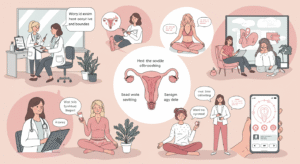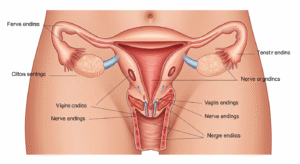1) What “health sexuality” means
Health and sexuality (or sexual health) is more than the absence of disease. The World Health Organization defines sexual health as a state of physical, emotional, mental and social well-being in relation to sexuality — it includes positive, respectful relationships and the freedom to have safe, pleasurable sexual experiences without coercion, stigma or violence. This definition highlights that sexual wellbeing spans rights, relationships and medical care.
2) Why sexual health matters for whole-body wellbeing
Health and sexuality affects mood, self-image, relationship satisfaction and overall quality of life. Problems with desire, arousal, pain or orgasm can increase anxiety and depression, and conversely mental-health issues and chronic disease commonly reduce sexual wellbeing. Because sexual health sits at the intersection of physical and mental health, addressing it often gives benefits across other areas of life — sleep, mood, partnership and self-confidence. Recent reviews emphasise sexual health across the life course, from adolescence to older age, and recommend integrated care.

3) Common sex health problems women face
Women commonly report several clusters of problems that fall under “sex health” concerns:
- Low desire — reduced interest in sexual activity.
- Arousal problems — decreased lubrication, difficulty feeling “turned on.”
- Pain with sex (dyspareunia) — pain at penetration or deep pelvic pain.
- Orgasmic difficulties — trouble reaching climax or delayed orgasm.
- Sexual response changes with life events — pregnancy, breastfeeding, surgery, chronic illness or menopause can change sexual function.
Clinical guidance shows sexual problems are common and that many women experience them at different life stages; acknowledging the issue is the first step toward treatment.
4) How clinicians assess sexual health
A thorough Health and sexuality assessment is practical and focused — it usually includes:
- History: timeline of symptoms, medication and medical history, mental-health screen, relationship factors and any history of sexual trauma.
- Physical exam: pelvic exam when indicated (to check for infection, atrophy, pelvic floor tenderness, scarring).
- Targeted investigations: only if they will change management (e.g., infection tests, pregnancy test, thyroid function or targeted hormone tests).
- Goal setting: what the patient wants to achieve (less pain, more desire, better intimacy).
Professional bodies recommend this multi-domain assessment because sexual problems rarely have a single cause. ACOG’s practice guidance lays out this approach clearly and supports coordinated, patient-centred care.
5) Simple, evidence-based steps you can try today
Many improvements come from low-risk, immediate changes. Try these consistently for 4–8 weeks and track results:
- Improve sleep and reduce stress. Sleep debt and chronic stress are powerful libido-killers.
- Use water-based lubricants or vaginal moisturizers for dryness and friction-related pain. These often provide quick relief.
- Limit alcohol before intimacy. While it lowers inhibitions, it can blunt arousal and sensitivity.
- Prioritise non-sexual intimacy. Touch, massage, eye contact and date time rebuild emotional safety and desire.
- Keep a short symptom diary. Note patterns tied to medications, menstrual cycle, sleep and mood — it helps your clinician pinpoint causes.
- Avoid irritants. Use pH-neutral cleansers; avoid scented soaps that can inflame vulvar skin.
If a simple change (like lubricant or treating a yeast infection) solves the problem, that’s a quick win. If not, a clinician visit is the next step. NHS resources provide practical local care options and clear signposting for testing and clinics.
6) Sex medicine, therapy and pelvic care
When simple measures aren’t enough, evidence supports a range of targeted interventions. Think of care as tiers: education and therapy first, pelvic health and topical/local treatments next, and medication or specialist procedures when appropriate.
Education & therapy (often first-line)
- Sex therapy and counselling (individual or couples) address communication, anxiety and relationship factors. Talking about sexual needs is a powerful therapeutic step. Mayo Clinic resources highlight structured ways to bring these topics up with a partner.
Pelvic health
- Pelvic floor physiotherapy for tight or painful pelvic floor muscles, vaginismus or chronic pelvic pain — guided exercises and graded desensitisation help many women.
- Topical/local treatments such as vaginal estrogen for menopausal urogenital symptoms, or topical analgesics for vestibular pain, are effective for specific diagnoses.
Medical options
- Medication review — many medications (SSRIs, some antihypertensives) affect sexual function; alternative regimens may be possible.
- Specific pharmacologic treatments — for clearly diagnosed disorders, certain medications are available in selected patients, and contraception or hormone therapy may help in life-stage related problems. These decisions require informed discussion about benefits and side effects.
Multidisciplinary care
The best outcomes often come from a combined plan involving a clinician, pelvic physiotherapist and psychologist/sex therapist. WHO and public health guidance recommend integrated services that respect rights, consent and diversity.
7) When to seek specialist input
Book a medical review if you have any of the following:
- Pain during sex that is new, worsening or limits intercourse.
- Persistent low desire or arousal that causes distress.
- Suspected infection (unusual discharge, fever) or bleeding.
- A medication change that coincided with reduced sexual function.
- A history of pelvic surgery, cancer treatment, or sexual trauma.
Specialist sexual-health clinics, gynecology departments and multidisciplinary centers provide targeted pathways — from testing and pelvic physiotherapy to sex therapy and specialist sex medicine.
8) Helpful enhancements — checklists, conversation starters, exercises
Clinic appointment checklist
- Short timeline of problems (when started, pattern).
- Full list of medications and supplements.
- Notes on sleep, mood, stress and relationship changes.
- Your top two goals for treatment.
Conversation starters
- With partner: “I want to talk about our sex life — I’ve been feeling [low desire/pain/etc.] and I’d like us to work on it together.”
- With clinician: “I’m having trouble with [pain/desire/arousal]. Can we make a plan to find the cause and options?”
Practical exercises (4–8 weeks)
- Sensate focus: short, non-demanding touch sessions to rebuild safe pleasure.
- Breathing + pelvic relaxation: 5–10 minutes daily of diaphragmatic breathing and pelvic relaxation.
- Micro-goals: one small intimacy goal per week (a phone-free dinner, a short evening walk).
9) Author & review box
Author: Dr. Kusuma — Founder, Female Sexual Health by Dr. Kusuma — 10 years’ clinical experience in gynecology and sexual medicine.
Clinic: Androcare — Swetha Scans, 67-A, Journalist Colony, Road No. 70, Jubilee Hills, Hyderabad — 500033.
Website: femalesexualhealth.in
Clinical reviewer: Senior gynecologist / sexual medicine consultant (content checked against WHO, ACOG and major clinical reviews).
10) FAQ
Q: What’s the difference between “sex health” and “sexual dysfunction”?
Q: How quickly do treatments work?
Q: Is it normal to have changes in sex health after childbirth or menopause?
Q: Where can I get confidential sexual health services?
Practical closing
Pick one small, low-effort action now: buy a quality water-based lubricant and try it during intimacy, or schedule a 15-minute conversation with your partner about how you’re feeling. If the problem continues, book a focused medical review — a clear plan helps most people feel better.
If you’re in Hyderabad and prefer local, evidence-based care, Female Sexual Health by Dr. Kusuma offers confidential, multidisciplinary assessment at Androcare — Swetha Scans, 67-A, Journalist Colony, Road No. 70, Jubilee Hills, Hyderabad — 500033. Visit femalesexualhealth.in for appointments and resources.






